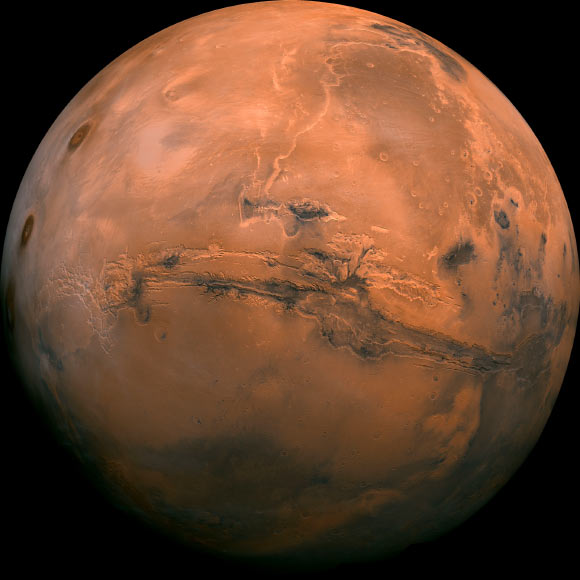The Tunable Laser Spectrometer (TLS) in the Sample Analysis at Mars (SAM) chemistry lab onboard NASA’s Curiosity rover has detected atmospheric methane during four nighttime measurements at Gale Crater on Mars, but no methane during two daytime measurements; this day-night difference suggests that methane accumulates while contained near the surface of Gale Crater at night, but drops below the instrument’s detection limits during the day, consistent with the daytime nondetection by instruments on board ESA’s Trace Gas Orbiter (TGO). Their results appear in the journal Astronomy & Astrophysics.

Mosaic of the Valles Marineris hemisphere of Mars projected into point perspective, a view similar to that which one would see from a spacecraft. The distance is 1,550 miles (2,500 km) from the surface of the planet. The mosaic is composed of 102 Viking Orbiter images of Mars. The center of the scene shows the entire Valles Marineris canyon system, over 1,240 miles (2,000 km) long and up to 5 miles (8 km) deep, extending form Noctis Labyrinthus, the arcuate system of graben to the west, to the chaotic terrain to the east. Many huge ancient river channels begin from the chaotic terrain from north-central canyons and run north. The three Tharsis volcanoes (dark red spots), each about 15.5 miles (25 km) high, are visible to the west. South of Valles Marineris is very ancient terrain covered by many impact craters. Image credit: NASA / JPL-Caltech.
The atmosphere of Mars is composed largely of carbon dioxide (95%), nitrogen (3%), argon (1.6%) as well as traces of oxygen and water.
The presence of methane in the Martian atmosphere was first detected in 2003.
On Earth, methane is produced by microbes that help most livestock digest plants.
While there are no cattle on Mars, finding methane there is exciting because it may imply that microbes were, or are, living on the planet. However, geological processes that involve the interaction of rocks, water, and heat can also produce it.
But before identifying its source, planetary scientists must settle a question that’s been gnawing at them: why do some instruments detect the gas while others don’t?
Curiosity, for instance, has repeatedly detected methane right above the surface of Gale Crater.
But TGO hasn’t detected any methane higher in the Martian atmosphere.
“When TGO came on board in 2016, I was fully expecting the orbiter team to report that there’s a small amount of methane everywhere on Mars,” said TLS instrument leader Dr. Chris Webster, a researcher at NASA’s Jet Propulsion Laboratory.
The TLS instrument has measured less than one-half part per billion in volume of methane on average in Gale crater. These measurements have been punctuated by baffling spikes of up to 20 parts per billion in volume.
“But when the TGO team announced that it saw no methane, I was definitely shocked,” Dr. Webster said.
The researchers were jolted by the TGO findings and immediately set out to scrutinize the TLS measurements on Mars. Some experts suggested that the Curiosity rover itself was releasing the gas.
“So we looked at correlations with the pointing of the rover, the ground, the crushing of rocks, the wheel degradation — you name it,” Dr. Webster said.
“I cannot overstate the effort the team has put into looking at every little detail to make sure those measurements are correct, and they are.”
The scientists hypothesized that the discrepancy between methane measurements comes down to the time of day they’re taken.
Because it needs a lot of power, TLS operates mostly at night when no other Curiosity instruments are working.
“The Martian atmosphere is calm at night, so the methane seeping from the ground builds up near the surface where Curiosity can detect it,” said Dr. John Moores, a planetary scientist at York University.
TGO, on the other hand, requires sunlight to pinpoint methane about 5 km (3 miles) above the surface.
“Any atmosphere near a planet’s surface goes through a cycle during the day,” Dr. Moores said.
“Heat from the Sun churns the atmosphere as warm air rises and cool air sinks.”
“Thus, the methane that is confined near the surface at night is mixed into the broader atmosphere during the day, which dilutes it to undetectable levels.”
Immediately, the authors decided to test this prediction by collecting the first high-precision daytime measurements.
TLS measured methane consecutively over the course of one Martian day, bracketing one nighttime measurement with two daytime ones.
“We predicted that methane should effectively go down to zero during the day, and our two daytime measurements confirmed that,” said SAM principal investigator Dr. Paul Mahaffy, a researcher at NASA’s Goddard Space Flight Center.
“TLS’ nighttime measurement fit neatly within the average we had already established. So that’s one way of putting to bed this big discrepancy.”
While this study suggests that methane concentrations rise and fall throughout the day at the surface of Gale Crater, planetary scientists have yet to solve the global methane puzzle at Mars.
_____
Christopher R. Webster et al. 2021. Day-night differences in Mars methane suggest nighttime containment at Gale crater. A&A 650, A166; doi: 10.1051/0004-6361/202040030







